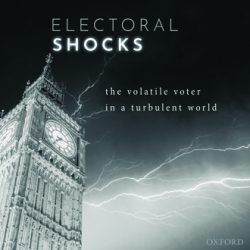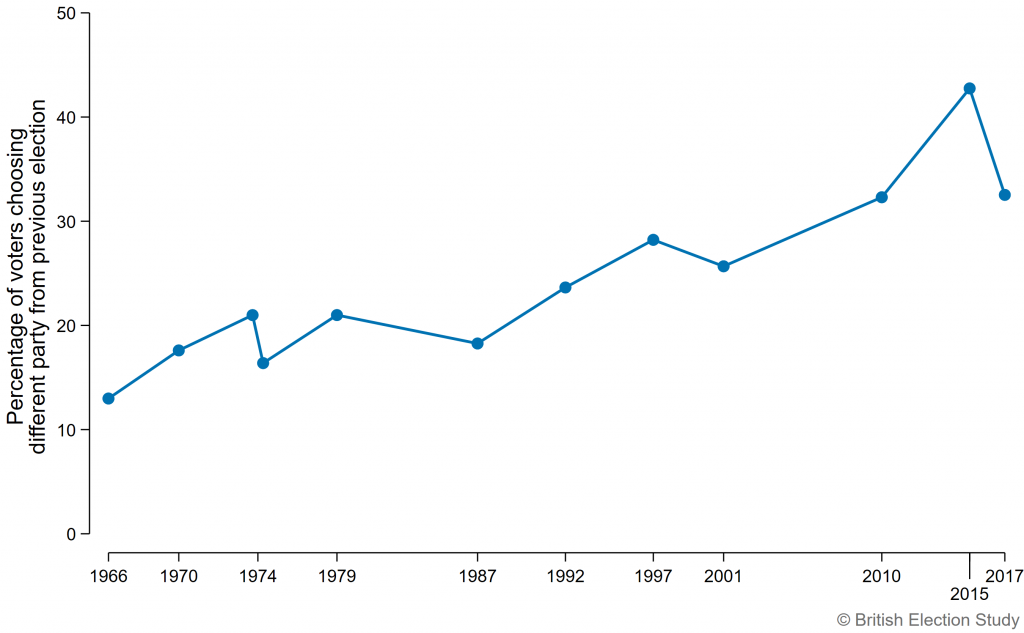‘Electoral Shocks: The Volatile Voter in a Turbulent World‘ by the British Election Study team is published today by Oxford University Press
The book offers a novel perspective on British elections, focusing on the role of electoral shocks in the context of increasing electoral volatility. It demonstrates and explains the long-term trend in volatility, how shocks have contributed to the level of electoral volatility, and also which parties have benefited from the ensuing volatility.
It follows in the tradition of British Election Study books, providing a comprehensive account of specific election outcomes—the General Elections of 2015 and 2017—and a more general and novel approach to understanding electoral change.
The focus on electoral shocks offers an overarching explanation for the volatility in British elections, alongside the long-term trends that have led us to this point. It offers a way to understand the rise and fall of the UK Independence Party, Labour’s disappointing 2015 performance and its later unexpected gains, the collapse in support for the Liberal Democrats, the dramatic gains of the Scottish National Party in 2015, and the continuing period of tumultuous politics that has followed the EU referendum and the General Election of 2017. It provides a new way of understanding electoral choice in Britain, and beyond.
Increasing Volatility
The 2015 and 2017 general elections displayed the highest levels of individual level voter volatility we have seen in modern times (see Figure below). In 2015, 43% of people voted for a different party than in 2010, and there was the highest share of the vote on record for parties other than the big three. By contrast, in 2017, we saw the highest two-party share since 1970. 33% of people changed their vote from 2015, and there was the highest switch of voters from Labour to Conservative and Conservative to Labour recorded in BES data. Across the three elections, 2010/15/17, 49% of people, almost half, did not vote for the same party. Only 51% remained loyal.
Individual-level voter volatility between elections recorded by the BES since 1964
Why is this happening?
There is a long-term trend of partisan dealignment (weakening party identification) amongst voters. This means they are more susceptible to changing their vote between elections. The new cohort of voters are less partisan than those they are replacing; they have less of the party loyalty of their parents. Voters have also had more choice as smaller parties have broken through via local and European elections. These smaller parties find it far more difficult to hold onto their vote, so as these parties become more important, they add to volatility in the electorate. However, these factors alone do not explain the level of volatility we have seen.
‘Electoral shocks’ over recent years offer an over-arching explanation for the unpredictability we have witnessed, and the parties that have benefited from it; from the surge in minor party votes in 2015 to the surge in two-party share in 2017. Furthermore, the impact of the shocks has been amplified by volatility, as unattached voters are more easily moved by the force of the shock.
What are Electoral Shocks?
Shocks can come in the form of major political decisions, important events or even political outcomes themselves. They have three defining characteristics. First, they represent an abrupt and unanticipated change usually coming at least partly from outside of the political system; second, they are highly salient, so they are noticeable even to people not interested in politics and can’t be easily ignored; and third they are relevant to party politics, so have the potential to change how parties are perceived.
We also identify the three main mechanisms for how shocks affect electoral politics. First, shocks change how important or salient different issues are to voters; second they change the extent to which different parties are seen to be competent at handling different aspects of government such as the economy; and third, they change the social or political image of the parties by altering who and what the different parties are seen to represent.
We examine five electoral shocks that affected the elections of 2015 and 2017: the rise in immigration after 2004, particularly from Eastern Europe; the Global Financial Crisis prior to 2010; the coalition government of the Conservatives and the Liberal Democrats between 2010 and 2015; the Scottish Independence Referendum in 2014; and the European Union Referendum in 2016.
What the experts say
“Politics has changed so much since I wrote Political Change in Britain, and this fascinating book explains why. Charting the rise in voter volatility in Britain and how political events influence decisions, it provides a fresh way of thinking about elections. It is essential to the understanding of why British politics is so much more unpredictable than it has been over the lifetime of my career.”
– Sir David Butler, Emeritus Fellow Nuffield College, author of Political Change in Britain and co-founder of the British Election Study
“In Electoral Shocks, an esteemed group of researchers reveals how the long-term softening of partisan loyalties set the stage for a series of abrupt, highly visible jolts that buffeted British voters and roiled British politics. Their careful analysis of who switched sides, when, and why, holds important implications for understanding the current wave of upheaval gripping countless democracies around the world.”
– Ted Brader, Professor Political Science, University of Michigan Principal Investigator American National Election Study
“Electoral Shocks offers a thorough and detailed analysis of recent developments in British politics and voters’ reactions to those events. This ambitious book project moves way beyond an analysis the determinants of voters’ choices in elections or the Brexit referendum, however. Mobilizing a wealth of historical survey data and unique panel-designs, Fieldhouse et al. seek to uncover the sources of the increased volatility and unpredictability of British politics. The theoretical argument that is developed and empirically tested in this book is compelling, and there is no doubt that it will prove applicable in other countries that are facing the consequences of dealignment. Electoral Shocks combines strong theory with a data-rich and meticulous data-analysis. This book is a ‘tour de force’ by any standard.”
– Ruth Dassonneville, Canada Research Chair in Electoral Democracy, University of Montreal
Electoral Shocks: The Volatile Voter in a Turbulent World can be ordered from OUP or from Amazon.


